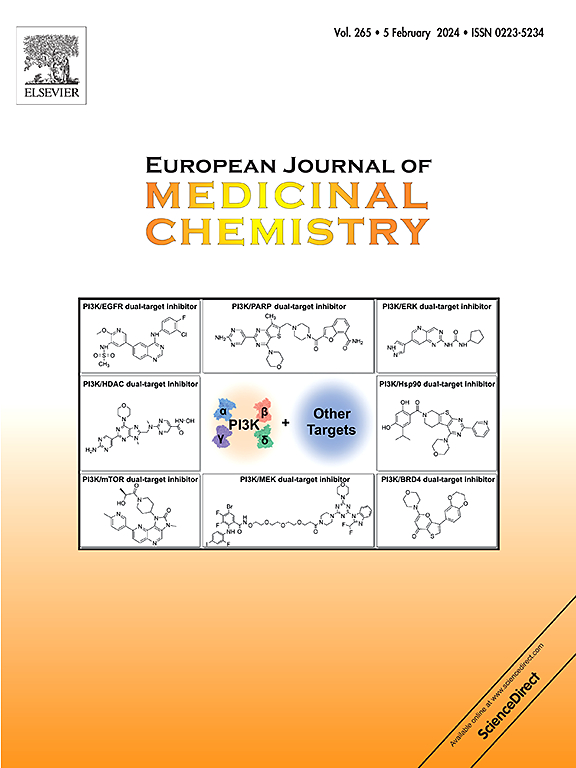含肟部分的反式a2b -辅助剂:肺癌光动力治疗的新型光敏剂
IF 6
2区 医学
Q1 CHEMISTRY, MEDICINAL
引用次数: 0
摘要
基于亚硝基烯烃对二吡咯烷的反应性,合成了14个含肟段的反式a2b -衍生物,以评价其作为肺癌光动力治疗(PDT)的安全治疗选择的潜力。这些大环具有光物理和酸碱性质,适合用作生物系统中的光敏剂。通过评价化合物对人肺癌细胞株(A549和H1299)的光动力作用,建立了结构-光动力活性关系。观察到的强光动力活性表明肟基在提高生物活性方面起着至关重要的作用。事实上,不含肟基片段的模型corrole(5,10,15-三苯基corrole)对所研究的LC细胞系(IC50>10 μM)没有光动力学活性,而所有14种肟基功能化的corrole的IC50值都显着降低。其中,三唑肟类衍生物的活性最高,其次是苯基肟类和甲基肟类衍生物。主要光敏剂的IC50值低于50 nM,本身没有细胞毒性,优于临床批准的PS Foscan®中的活性化合物Temoporfin。这表明肟功能化的反式a2b -衍生物是LC光动力治疗的有希望的候选药物。在鸡胚绒毛膜-尿囊膜模型上,对一种肟-咯咯基PDT的体内功效进行了评估,证明了其作为一种有效的体内光敏剂的潜力。本文章由计算机程序翻译,如有差异,请以英文原文为准。


trans-A2B-Corroles containing an oxime moiety: Novel photosensitizers for photodynamic therapy of lung cancer
A series of fourteen trans-A2B-corroles containing an oxime moiety were synthesized based on the reactivity of nitrosoalkenes towards dipyrromethanes, to evaluate their potential as a safe therapeutic option for photodynamic therapy (PDT) of lung cancer (LC). These macrocycles exhibited photophysical and acid-base properties suitable for use as photosensitizers (PS) in biological systems. Structure-photodynamic activity relationships were established by evaluating the photodynamic effects of the compounds on human lung cancer cell lines (A549 and H1299). The strong photodynamic activity observed demonstrated that the oxime group plays a crucial role in enhancing biological activity. In fact, the model corrole without an oxime moiety (5,10,15-triphenylcorrole) showed no photodynamic activity against any of the studied LC cell lines (IC50 > 10 μM), whereas all fourteen oxime-functionalized corroles exhibited significantly lower IC50 values. Among them, triazole-oxime derivatives displayed the highest activity, followed by phenyl-oxime and methyl-oxime corroles. The lead photosensitizers, with IC50 values below 50 nM and no cytotoxicity per se, outperformed Temoporfin, the active compound in Foscan®, a clinically approved PS. This highlights oxime-functionalized trans-A2B-corroles as promising candidates for photodynamic therapy of LC. The in vivo efficacy of one oxime-corrole based PDT was also evaluated using the chick embryo chorioallantoic membrane model demonstrating its potential as an effective photosensitizer in vivo.
求助全文
通过发布文献求助,成功后即可免费获取论文全文。
去求助
来源期刊
CiteScore
11.70
自引率
9.00%
发文量
863
审稿时长
29 days
期刊介绍:
The European Journal of Medicinal Chemistry is a global journal that publishes studies on all aspects of medicinal chemistry. It provides a medium for publication of original papers and also welcomes critical review papers.
A typical paper would report on the organic synthesis, characterization and pharmacological evaluation of compounds. Other topics of interest are drug design, QSAR, molecular modeling, drug-receptor interactions, molecular aspects of drug metabolism, prodrug synthesis and drug targeting. The journal expects manuscripts to present the rational for a study, provide insight into the design of compounds or understanding of mechanism, or clarify the targets.

 求助内容:
求助内容: 应助结果提醒方式:
应助结果提醒方式:


